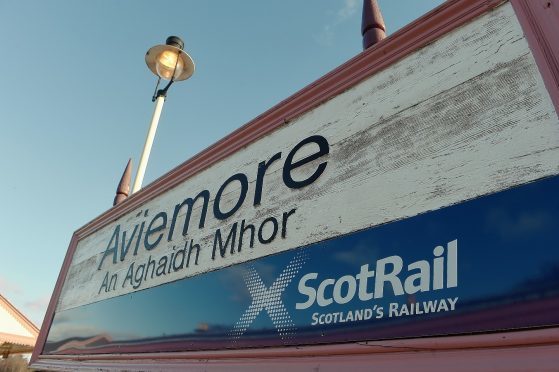Major upgrade works are being planned to slash rail journey times between Inverness and the central belt.
Railway bosses are drawing up proposals for the next stage of a revamp of the Highland Main Line between Inverness and Perth.
The Press and Journal has learned that they have settled on changes at two key stations as the best option to pave the way for an hourly service on the route, and to further cut journey times by another 10 minutes.
The line is the main link for passengers traveling onwards to Glasgow and Edinburgh – but much of the route is single track, which limits the amount of rail traffic which can use it.
Detailed designs for the upgrade are yet to be finalised – but it is understood that improvements at Aviemore and Pitlochry stations will be key to achieving the ambitions of transport chiefs.
Changes in signalling and track layout will allow two trains to enter the two stations simultaneously, which currently is not possible.
Contractors working for Network Rail have already begun carrying out ground investigation work ahead of drawing up detailed designs for the scheme.
It is anticipated that work could start next year – and it is scheduled for completion by March 2019.
Transport Scotland yesterday confirmed it has awarded a contract to engineering multinational Wsp Parsons Brinckerhoff to draw up a business case for the project.
Frank Roach, manager of north transport partnership Hitrans, said that the development’s on the Highland Mainline were “encouraging”.
He said: “It’s something that everybody wants to work towards.
“It will speed things up as it means that longer trains will be able to pass.”
He said that the changes would tie in with the planned introduction of “high speed trains” on the railways, due from the end of next year.
Mr Roach also suggested that changes to passing places on the line would allow longer freight trains to run on the route.
He said: “Everybody wants longer trains but at the moment it’s not possible because they can’t pass.”
The long term goal of the project is cut the quickest journey between Inverness and the central belt to just two hours and 45 minutes – with an average journey of three hours.
It is currently takes between three hours and 20 minutes and three hours and 38 minutes.
It is also anticipated that frequency could increase to an hourly service.
The project will be the second phase of the Highland Main Line upgrade, with the first having delivered two additional services and a journey time saving of up to 18 minutes.
Highland Labour MSP David Stewart welcomed the development – and said it was essential to stop travellers swapping to the roads rather than the railway.
He said: “Single track puts a real constraint on the line and limits the speed of trains and exacerbates delays.
“Anything that can be done to improve that has to be a good thing.
“In the long term we should be aiming for a dualling of the railway, the same as we have happening on the road.
“Otherwise we’ll see people voting with their feet and opting to drive rather than take the train.
“Improvements on the railway are good for climate change targets as well as passengers.”
Transport Scotland said it could not comment in detail on the current plans.
However, the agency has described upgrading the Highland Mainline as “one of the Scottish Government’s key priorities”.
Its description of phase two of the overall plan states: “Transport Scotland, on behalf of Scottish Ministers is working with Network Rail to develop phase two of the scheme which aims to deliver an hourly service, further journey time reductions of around 10 minutes and more efficient freight operations by March 2019.
“The project is currently at the design stage. Detailed information on the necessary works are anticipated in 2017.”










